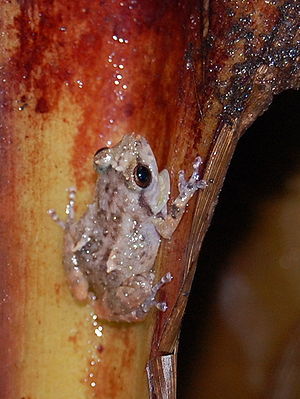- Common tink frog
-
Syrrhopus ineptus Barbour, 1928
Common tink frog male specimen in Osa Peninsula, Costa Rica Conservation status Scientific classification Kingdom: Animalia Phylum: Chordata Class: Amphibia Order: Anura Family: Leptodactylidae Genus: Eleutherodactylus Species: E. diastema Binomial name Eleutherodactylus diastema
(Cope, 1875)Synonyms Hyla chica Noble, 1918 The common tink frog or dink frog (Diasporus diastema) is a species of frog in the Leptodactylidae family, so-called because of the loud metallic "tink" sound that the male frog makes during the night (up to 40 times per minute). (Formerly also known as Eleutherodactylus diastema, Hyla chica, and Syrrhopus ineptus.) It is found in Costa Rica, Honduras, Nicaragua, western Ecuador, and Panama. Its natural habitats are subtropical or tropical moist lowland forests, subtropical or tropical moist montanes, plantations , rural gardens, and heavily degraded former forest, from sea level to 1800 meters (5900 ft) elevation.
Its color during daylight hours, when it hides, is grayish brown with spots or bars; when it emerges at night and becomes active, the frog takes on a pale pink or tan color.
Adult females reach sizes up to 1 inch (24 mm) long, and males to about 3/4 inch (21 mm). Dink frogs have no free-swimming tadpole stage, and instead emerge as miniature frogs directly from their eggs (laid in bromeliads and tended by the male frog).
The diet of the tink frog consists mainly of ants and other arthropods.
References
- Pounds, A., Bolaños, F., Solís, F., Ibáñez, R., Jaramillo, C., Chaves, G., Savage, J., Acevedo, M., Cruz, G., Wilson, L.D. & Köhler, G. 2004. Diasporus diastema. 2006 IUCN Red List of Threatened Species. Downloaded on 22 July 2007.
- Kinsey, T. Beth, Dink Frogs, The Firefly Forest web site, retrieved July 2008.
- Common Tink Frog, Anywhere Costa Rica web site, retrieved July 2008.

This Leptodactylidae article is a stub. You can help Wikipedia by expanding it.


